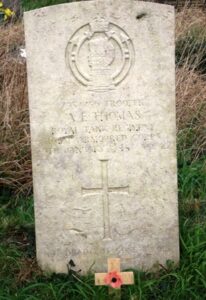Greenhill Secondary School, which is the old Greenhill Grammar School, contains two wooden war memorials, which commemorate the pupils who fell during both world wars. The photographs of the memorials are courtesy of Mike Berrell. This page commemorates these pupils of the former Greenhill Grammar School.
The Great War, 1914-1918
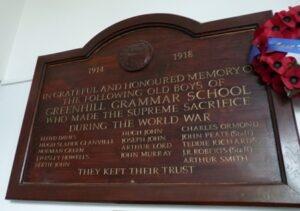
Thomas Lloyd Davies, Third Mate, Mercantile Marine. Thomas was the son of Thomas and Sarah Jane Davies, of Glyder, Manorbier. He served in the Mercantile Marine, aboard the Belfast registered cargo steamer S.S. Galgorm Castle. On 27 February 1917 Galgorm Castle was en-route from Buenos Aires to Queenstown when she was shelled and sank by the German submarine U-49, with the loss of eleven lives. Thomas was 19 years old when he died that day, and is commemorated on the Tower Hill Memorial, London.
Hugh Slader Glanville, Private, 320299, Welsh Regiment. Hugh was the son of James Cox Slader Glanville and Anna Maria Glanville, of Llanteg. He enlisted at Carmarthen into the Pembroke Yeomanry, with the service number 4286. The Pembroke Yeomanry had formed in Tenby for Home Defence, as part of the South Wales Mounted Brigade. They arrived in Egypt in March 1916, and on 2 February, 1917 were disbanded, joining with the Glamorgan Yeomanry to form the 24th Battalion of the Welsh Regiment, as part of 231 Brigade, 74th (Yeomanry) Division. Hugh’s service number then changed to 320299. The Division first saw action during the Second Battle of Gaza. Hugh was wounded during the Third Battle of Gaza, and Died of Wounds on 11 November, 1917, aged 26. He is buried at Beersheba War Cemetery, Israel. His brother William Leslie Glanville served alongside him, and at the time of Hugh’s death was wounded and in Hospital at El Arish, Egypt. Fortunately William survived the war.

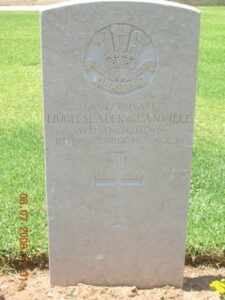
Cyril Norman Green, Driver, 122243, Royal Field Artillery. Cyril was the son of John and Bessie Rundle Green, of 7, Bridge Street, Haverfordwest. He was a bit of a wanderer, having formerly resided at Tenby, Brecon, and Haverfordwest prior to the war. Cyril was living at Haverfordwest when he enlisted into the Royal Field Artillery, joining their 55th Division Ammunition Column, attached to the 55th (West Lancashire) Division. The Division was reformed in France during January 1916, and relieved the French 88th Division south of Arras, in the area Wailly- Bretencourt by 16 February. Trench warfare commenced, with many raids and minor operations. Relieved by the 11th (Northern) Division on 25 July, the Division now moved south and took up a place in the front line opposite the village of Guillemont. Here they fought at the Battle of Guillemont and the Battle of Ginchy. There was a short period of rest at Ribemont from 12 to 17 September, and then the Division fought at the Battle of Flers-Courcelette and the Battle of Morval. Relieved by 41st Division on 28 September, the Division withdrew to the area of Buire and Ribemont, before relieving the 29th Division in the Ypres salient in October 1916. It was destined to remain in this area for almost a year, stationed near Railway Wood. Cyril was wounded at Railway Wood, and evacuated to the Military Hospital at Boulogne, where he died of his wounds on 11 March 1917. He was 21 years old, and is buried at Boulogne Eastern Cemetery, France.
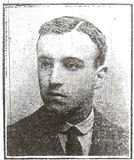
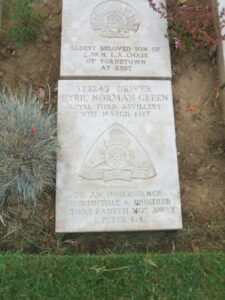
Reverend John Wesley Howells, Second Lieutenant, Lancashire Fusiliers. John was born on 26 October 1887, the son of William and Sarah Jane Howells, of Arch House, St. George Street, Tenby. He was educated at Tenby, before training at Westminster, becoming a Wesleyan Minister at Manchester prior to the war. John enlisted on 14 May 1915, and was commissioned in August that year into the 7th Battalion, Lancashire Fusiliers. The Battalion was formed in Salford in August, 1914, as part of the East Lancashire Division, and had been in Egypt since 25 September 1914, being landed on Gallipoli on 5 May 1915. John joined the Battalion when it had returned to Egypt from Gallipoli, but soon transferred to the Royal Flying Corps, training as an Observer, attached to 14 Squadron, RFC. On 23 July 1917, John was flying as Observer to Lieutenant R. N. Thomas, in their BE2e, when it suffered a direct hit by anti-aircraft fire, South-West of Gaza, Palestine. Both men were killed when the aeroplane crashed into the sea. Both John and his Pilot are commemorated on the Jerusalem Memorial, Israel, and also on a private memorial at Beersheba.
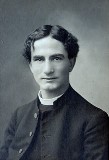
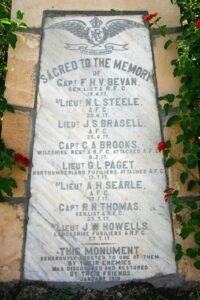
Albert James John, Private, 45482, Lancashire Fusiliers. Bertie was born at Broomhill, Minwear on 20 October 1898, the son of David John and Catherine Ann John (nee Lewis). The family later resided at St. Florence, and Albert was educated at Greenhill Grammar School. At some time during the war the family had moved again, to Amberley House, Pembroke. Albert enlisted at Carmarthen into the Pembroke Yeomanry, and at some time after 1916 was posted to France, joining the 18th Battalion, Lancashire Fusiliers. The battalion was attached to 104 Brigade, 35th Division, and saw its first major action on the Somme. After being drastically re-manned, the Division then went back into the line, and followed the German Retreat to the Hindenburg Line in March 1917. Later in the year they moved north to Ypres, and fought at the Second Battle of Passchendaele. Albert was killed in action at Passchendaele on 22 October 1917, aged 20. He has no known grave, and is commemorated on the Tyne Cot Memorial, Belgium. He had originally been reported as missing two days prior to the official date of his death. His brother Joseph also fell.
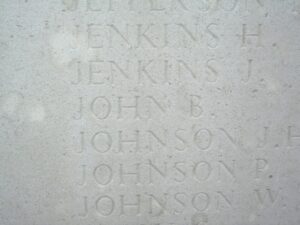
Griffith Hugh Davies John, Gunner, 3123, Australian Artillery. Hugh was born on 19 July 1892, the son of William Davies John and Sarah Catherine John, of Cresselly Shop. He had emigrated to Australia prior to 1914, where he worked as a Farmer. By the summer of 1915 the Australian Imperial Force was making a name for itself during the fighting at Gallipoli. Many young Australians flocked to join the AIF, to take part in this great adventure that the propaganda had promised them, and so on 25 June 1915 Hugh enlisted at Blackboy Hill into the Australian Infantry, after being turned down from the Light Horse. After training, Hugh was posted to the 10th Reinforcements for the 16th Battalion, AIF, and embarked at Fremantle aboard HMT Themistocles on 13 October 1915 bound for Egypt. Early in 1916 the Australian battalions that had fought on Gallipoli were divided up to double the size of the AIF, with half the men going to the new battalions, and the positions being taken up by reinforcements. As a result, Hugh was posted to the 48th Battalion, AIF. His service papers then show a long history of illness, with several spells in hospitals in England over the coming months. In June 1917 he was posted to the 7th Field Artillery Battery, Australian Field Artillery, and in August was shot in the buttocks while fighting at Ypres. Again Hugh was hospitalised, and it was not until February 1918 that he was back in France, but he was soon in hospital ill again. Yet again Hugh returned to action, but was wounded for a second time during October 1918, during the fighting around the Hindenburg Line, and returned home for treatment at the Red Cross Hospital, Sittingbourne. Sadly Hugh took ill here and died of pneumonia on 30 October 1918. He was 26 years old, and was brought home for burial at Minwear (St. Womar) Churchyard.
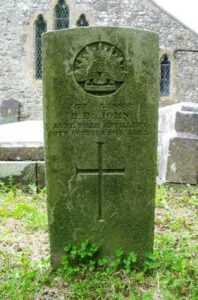
Joseph Davies John, Private, 645, Australian Imperial Force. Joseph was born at Broomhill, Minwear, Narberth in 1893, the son of David and Catherine Ann John. The family later resided at Tenby, where Joseph was educated, and at Amberley House, Pembroke. Joseph had migrated to Australia with his cousins in 1910, aged only 17, and enlisted at Perth, NSW on 12 March 1915 into the 28th Battalion, Australian Infantry, who were attached to 7 Brigade, 2nd Australian Division. Joseph landed on Gallipoli on 5 September 1915 and was wounded in the thigh two weeks later, which required him to be evacuated and sent to Egypt for treatment. On 15 January 1916 Joseph returned to his unit, and on 16 March 1916 the Battalion embarked at Alexandria to France, disembarking at Marseilles on 21 March. In France, the Australian Imperial Force were posted to the line near Fleurbaix, where they were initiated into the rigours of trench warfare on the Western Front. In mid July, the ANZACS were sent to the Somme, where they were to take the formidable German positions at Pozieres Ridge. The first attack was carried out successfully by the First Division, and on 27 July 1916, the Second Division replaced them at Pozieres. Joseph was posted as missing during the continued fighting at Pozieres, and was finally certified as Killed in Action on 29 July 1916. He was 22 years old, and is remembered on the Villers-Brettoneux Memorial, France.
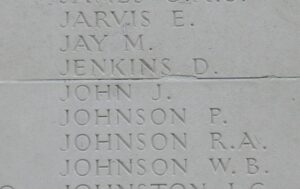
Arthur George Lord, Second Lieutenant, Royal Welsh Fusiliers. Arthur was the son of George and Phoebe Lord, of Fairfield, Tenby, and had been commissioned in June 1915 from the 16th Battalion, Middlesex Regiment into the 3rd Battalion, Royal Welsh Fusiliers. He transferred into the 2nd Battalion, which had been on the Western Front since 11 August 1914. Arthur landed in France on 6 May 1916, joining the battalion near Fricourt, on the Somme, where it was attached to the 33rd Division. The battalion claimed among its ranks the renowned war poets Siegfried Sassoon and Robert Graves. The battalion took part in the successful capture of Mametz Village, at the opening of the Somme Offensive, and pulled out of the line to rest before the 38th Welsh Division captured Mametz Wood. The 33rd Division then moved back into the line, and took part in the assault on High Wood. This is where Arthur was Killed in action aged just 20, on 20 July 1916. His body was lost on the battlefields, and so he is remembered on the Thiepval Memorial, France.
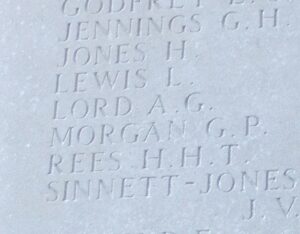
John Claude Murray, Second Lieutenant, South Wales Borderers. John was born in 1884, the son of William and Elizabeth Murray, of Treberth Farm, Saundersfoot. He was commissioned into the 2nd Battalion South Wales Borderers, who were in Tientsin, China at the outbreak of War. After a famous encounter with German forces at Lao Shan, they returned to Hong Kong, where they embarked for the U.K. on 4 December 1914. They arrived at Plymouth on 12 January 1915, and here they were attached to 87 Brigade, 29th Division. The Division sailed from Avonmouth on 16 March 1915 and landed at Egypt, from where they embarked to Mudros on the 10th April. They landed at Cape Helles, Gallipoli, on 25 April 1915, and remained there for the duration, suffering heavy casualties. On 2 January 1916 the Division was withdrawn from Gallipoli, and landed at Marseilles (via Egypt) on 29 March 1916. The first engagement for the Division was at the opening of the Battle of the Somme, between Beaumont Hamel and Thiepval, where the 2nd S.W.B. suffered heavily. John was killed in action on 9 July 1916, aged 31. He is commemorated on the Thiepval Memorial, France.

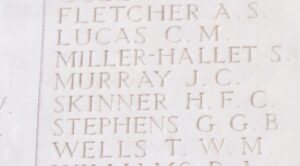
Charles Ormond, Engine Room Artificer 3rd Class, 271703, Royal Navy. Charles was born on 23 January 1889, the son of John and Martha Ormond, of the Cambrian Hotel, Saundersfoot. He served as a pre war regular in the Royal Navy, aboard H.M.S. Defence. Defence was a Minotaur Class Armoured Cruiser, and was stationed in the Mediterranean at the start of the war. She became the flagship of the First Cruiser Squadron, and took part in the Battle of Jutland. During the height of the Battle, the Defence was closing in on the crippled SMS Wiesbaden, when she was hit by a German salvo in the magazine. She blew up and sank almost immediately, taking down with her the entire crew of 903 men. Charles was 27 years old when he was killed in the sinking of Defence on 31 May 1916. He is commemorated on the Plymouth Naval Memorial, Devon.
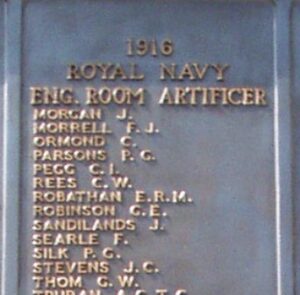
John Peate, Lieutenant, Gloucestershire Regiment. John was born at Llanbrynmair in 1889, the son of Margaret Peate of Ddolfach. He was educated at Machynlleth and Aberystwyth University, and was on the staff at Greenhill Grammar School, Tenby prior to the war. John married Ethel Gertrude Hicks at Tenby in 1915 and the couple lived at Marlborough House, South Cliff Street, Tenby. John was commissioned into the 3rd Battalion, Gloucestershire Regiment, and was posted into the 1st Battalion, Gloucestershire Regiment, which had been in France since the outbreak of war, attached to 3 Brigade, 1st Division. John joined the battalion in time to take part in the Somme Offensive on July 1916, probably arriving before the 1st Division moved to the Somme from Loos. By 5 July the 1st Gloucester’s had reached Bruay, and moved to billets in Albert by 11 July, prior to moving into the front line near Contalmaison. The 1st Division saw its first action on the Somme during the Battle of Bazentin soon afterwards, fighting to the right of the Australians as they assaulted Pozieres Ridge, and suffered terribly during the fighting around the OG lines. Heavy fighting, interspersed with rest periods, carried on over the coming weeks. By 7 September the 1st Gloucester’s moved into positions to carry on the offensive towards High Wood, and at dawn on the following morning launched their assault. Unfortunately the artillery support fell short, and many casualties were suffered from friendly fire. John was killed when the 1st Gloucester’s attacked High Wood on 8 September 1916. The 27-year-old has no known grave, and is commemorated on the Thiepval Memorial, France.
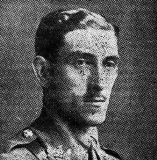
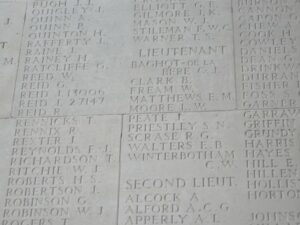
Ralph Jennings Roberts, Lieutenant, Machine Gun Corps. Ralph was the son of George Rowland Roberts and Janet Roberts, of Newquay, Cornwall. He was on the staff at Greenhill Grammar School prior to the war, and resided at Wonford Lodge, Tenby. Ralph was commissioned into the South Wales Borderers on 10 February 1915, and landed at Salonika on 1 December 1916. Ralph was posted to the 179th Company, Machine Gun Corps, attached to the 60th (2/2nd London) Division. The division had initially been on service in Ireland, but was posted to Salonika where it fought for ten months before being moved to Egypt, joining the forces in Palestine. Ralph was killed during his first action in Palestine, during the Third Battle of Gaza on 31 October 1917. He was 38 years old, and is buried at Beersheba War Cemetery, Israel. Many thanks to Avril Marks for the photograph.
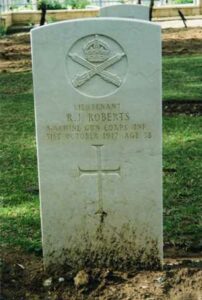
Arthur Smith, Private, 1155, Northamptonshire Yeomanry. Arthur was the only son of Charles Slater and Bertha Smith of Norton House Tenby. He had been born at River View, Woodford, Northants on 24 September 1890, and was educated at Lewisham College, Weston-Super-Mare. He volunteered into the Northamptonshire Yeomanry on 8 September 1914, and as a successful National Hunt Jockey was accepted with open arms. In October 1914 the Northants Yeomanry joined the 8th Division, and proceeded to France in November, and saw their first major action at Neuve-Chapelle, where Arthur was killed in action on 9 March 1915, aged 24. He is buried at Vieille-Chappelle New Military Cemetery, France.
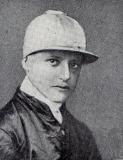
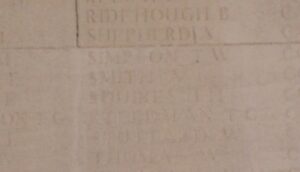
World War Two, 1939-1945
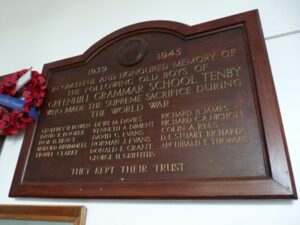
David Robert Booker, Sergeant (Air Bomber), 1413457, Royal Air Force Volunteer Reserve. David was born in India on 28 February 1923, the son of Arthur Booker, an engineer, and Mary Booker. In May 1926 the family returned home from India and settled back at Osborne House, Harris Street, Tenby. David was educated at Greenhill Grammar School and at Christ College. He enlisted into the Royal Air Force Volunteer reserve soon after the outbreak of war and after training as an Air Bomber was posted to 156 Squadron, Royal Air Force, which was part of the elite Pathfinder Force, armed with the Avro Lancaster heavy bomber. David was taking part in his third mission when his Lancaster, serial EE118, took off from RAF Warboys on 29 September 1943, bound for Bochum. The crew found their target and returned home, but sadly crashed near Downham Market, Norfolk on the return leg, killing most of the crew, including David. His body was taken back to Tenby, where he was laid to rest at St. Mary’s Church Cemetery.
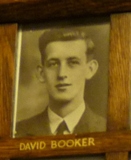
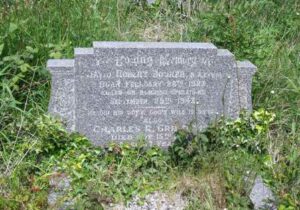
Geoffrey Hugh Bowen, Flying Officer (Pilot), 161261, Royal Air Force Volunteer Reserve. Geoffrey was the son of Percival and Mary A. Bowen (nee Smith), of West Cross, Swansea. He was educated at Tenby Council School and at Greenhill School prior to enlisting into the Royal Air Force. Geoffrey received a commission as a Pilot Officer on 27 October 1943. He was killed in an aeroplane crash at Melton Mowbray on 13 May 1944, aged 22, and is buried at Swansea (Oystermouth) Cemetery.
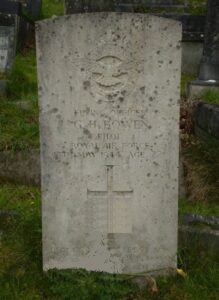
Ivor Henton Brace, Civilian Air Raid Victim, Auxiliary Fire Service. Ivor was the son of John and Mary Brace, of Knightson Lake, New Hedges, Tenby. He lived at 6 Cornwall Mews, London, where he served with the Auxiliary Fire Service. Ivor was killed at Elvaston Place, London, during an air raid on 11 May 1941. He was 27 years old.
Harold Felix Brumell, Ordinary Signalman, C/JX 176257, Royal Navy. Harold was the son of Felix Harold and Jane Brumell, of Walmer, Kent. He was educated at Tenby Council School and at Greenhill School prior to working for H.M. Customs and Excise. At the outbreak of war, Harold enlisted into the Royal Navy, where he served aboard HM Trawler Waveflower. Harold was among 14 men lost when Waveflower was sunk after striking a mine off Suffolk on 22 October 1940. He was 22 years old, and is commemorated on the Chatham Naval Memorial, Kent.
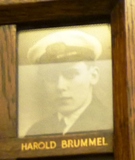
Lionel Elderton Clark, Assistant Cook, 118385, Naval Auxiliary Personnel (Merchant Navy). Lionel was born in Sussex in 1916, the son of Robert Charles Clark and Clara Elizabeth Elderton Clark. Robert had moved the family to Tenby during the Great War, where he was an instructor with the local Royal Garrison Artillery. Lionel was educated at Tenby Council School and Greenhill School, before joining the Merchant Navy, and served aboard HMS Jervis Bay as an Assistant Cook. Jervis Bay was a liner which had been converted into an Armed Merchant Cruiser in August 1939. On 5 November 1940, she was the sole escort for the 37 ship Convoy HX-84 from Halifax, Nova Scotia to Britain, when the convoy encountered the Pocket Battleship Admiral Scheer. The convoy scattered, and Jervis Bay set a course straight towards the German warship to draw its fire. Jervis Bay was hopelessly outmatched, and was sunk in the engagement. Lionel was killed in the sinking that day. He was 23 years old, and is commemorated on the Liverpool Naval Memorial. His brother, Eric Henry Clark also fell.
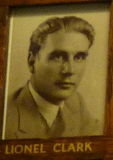
Dewi Madoc Davies, Sergeant, 1021734, Royal Air Force Volunteer Reserve. Dewi was the son of the Reverend David Davies and Catherine Ann Davies, of Saundersfoot. He was educated at Greenhill School, before enlisting into the Royal Air Force, and joined 228 Squadron, which operated the Short Sunderland, and was based at RAF Pembroke Dock. On 13 June 1943, Dewi was a crewman aboard Sunderland DV-967 when she spotted a surfaced German Submarine, U564, and attacked her. Although badly damaging the U-Boat, the Sunderland was shot down, and crashed, killing all eleven of the crewmen aboard. Dewi was just 20 years old, and is commemorated on the Runnymede Memorial, Surrey.
Kenneth Arthur Diment, Craftsman, 7588455, Royal Electrical and Mechanical Engineers. Kenneth was the son of Captain John Bennett Diment and Winnifred Mabel Diment (nee Pitkin) of Tenby. He served during the war with the Royal Electrical and Mechanical Engineers, but sadly little else is known of him. Kenneth died on 30 September 1945, aged 24, and is buried at Tenby (St. Mary) Church Cemetery.
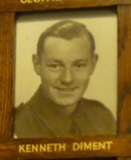
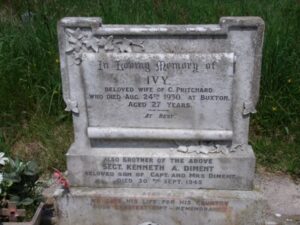
David Gwynne Evans, Flying Officer (Pilot), 132703, Royal Air Force Volunteer Reserve. David was the son of Sydney Charles and Evelyn Caroline Evans, of Hillside, Greenhill Avenue, Tenby. He was educated at Greenhill School before enlisting into the Royal Navy, training as an Engine Room Artificer at Portsmouth. David then became interested in flying, and left the Royal Navy to train as a Pilot with the Royal Air Force Volunteer Reserve. David then learnt to fly in Canada, with the Empire Air Training School, alongside David Booker from Tenby. Upon his return, he served as a Pilot with 86 Squadron, RAF, which was an anti shipping squadron, equipped with the Consolidated Liberator V. On 23 October 1943, David was co-pilot aboard Liberator FL954, which was detailed for convoy escort duty in the Atlantic. The aircraft took off but soon developed technical problems, and crashed at Lough Foyle, County Derry, Ireland, killing all eight of the crew. David was 22 years old, and was brought home to be buried at Tenby (St. Mary) Church Cemetery.
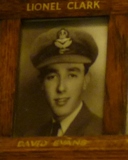
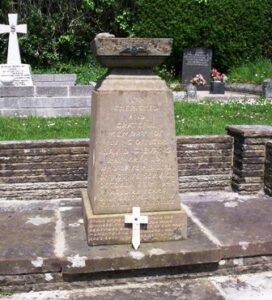
Norman John Evans, Captain, 193795, the Welch Regiment. Norman was born on 15 August 1916, the son of John Henry Tennent Evans and Elizabeth Evans (nee Badham), of 33, Brewery Street, Pembroke Dock. The family then moved to 19, Trafalgar Road, Tenby. Norman was originally commissioned from the Welsh Guards into the Welch Regiment on 11 July 1941, probably after serving with the Welsh Guards during the fall of France in 1940. He was attached to the 9th Battalion, Cameronians for the invasion of Normandy. The battalion was attached to 46 Brigade, 15th (Scottish) Division, and landed on 17 June 1944 onto the Normandy beaches. In the coming weeks, the Division took part in the break out from the beaches, and took part in heavy fighting. Norman was killed on 11 July 1944, aged 27. He is buried at Beny-Sur-Mer Canadian War Cemetery, Reviers, France. His brother Richard Charles Evans also fell.
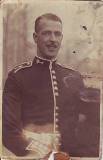
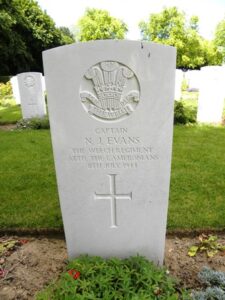
Donald Edward Grant, Pilot Officer, 133564, Royal Air Force Volunteer Reserve. Donald was the son of Thomas Edward and Edith Annie Grant, of Totton, Hampshire. He married Mary Ann Clisby in 1941. He served with 102 Squadron, RAF, which was a bomber Squadron, one of its officers being George Leonard Cheshire, VC, and was based at RAF Pocklington, flying the Lancaster. Donald was killed on a bombing mission over Germany on 5 March 1943. He was 24 years old, and is commemorated on the Runnymede Memorial, Surrey.
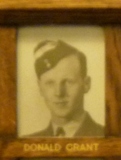
George Henry Griffiths, Sergeant (Air Gunner), 1835969, Royal Air Force Volunteer Reserve. George was the son of Harold Hector Griffiths and Alice Maud Griffiths (nee Rees), of Tenby. He served with 630 Squadron, RAF, which flew the Lancaster heavy bomber. On the night of 20 February 1944, George took off from RAF East Kirby aboard Lancaster III, Serial JB710, as part of a bombing group bound for Stuttgart. Sadly his aeroplane was one of two which were lost that night, with no survivors, and was never found. George was 19 years old, and is commemorated on the Runnymede Memorial, Surrey.
Richard Benjamin Vaughan James, Second Radio Officer, Merchant Navy. Richard was the son of William Benjamin James, and Lily Kate James (nee Vaughan), of Tenby. He served in the Merchant Navy, aboard SS Zurichmoor, a London registered cargo steamer. Zurichmoor, which was owned by Moor Line Ltd, had been sailing independently from Halifax, Nova Scotia to St. Thomas, Virgin Islands in ballast after crossing the Atlantic in Convoy ON-90. The ship and her crew of 44 never reached St. Thomas. The ship was not officially classed as missing/untraced until 29 July 1942. A German radio message was later intercepted claiming the ship had been sunk by U-432 on 23 May 1943 East of Philadelphia. Richard was 18 years old, and is commemorated on the Tower Hill Memorial, London.
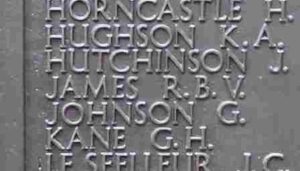
Richard Charles Andrew Nicholl, Marine, PLY/X 1995, Royal Marines. Richard was the son of Charles Thomas Nicholl and Mary Sophia Nicholl (nee Meyrick), of Tenby. He served aboard the aircraft carrier HMS Glorious. On the afternoon of Saturday 8 June 1940 HMS Glorious and her escorting destroyers HMS Acasta and HMS Ardent were intercepted in the Norwegian Sea by the German battle-cruisers Gneisenau and Scharnhorst while returning from supporting the British forces in Norway. The three British ships were sunk by gunfire in a little over two hours, with the loss of over 1,500 officers and men. Richard was one of the missing. He was 21 years old, and is commemorated on the Plymouth Naval Memorial, Devon.
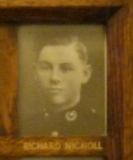
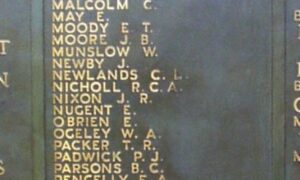
Colin Aveston Rees, Ordinary Seaman, D/JX. 651040, Royal Navy. Colin was the son of George Howard Rees and Sophia Ann Rees (nee Rees), of Pembroke Villas, Tenby, and served aboard the light cruiser HMS Diomede. Diomede had taken part in several naval actions during the early part of the war, but had become obsolete, and was transferred to Rosyth for use as a training vessel. Colin died at Rosyth on 17 January 1944. He was 18 years old, and is buried at Tenby (St. Mary) Church Cemetery.
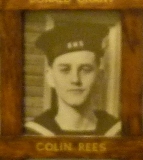
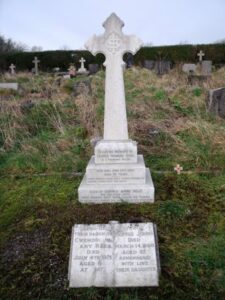
David Ernest Stuart Richards, Aircraftman 2nd Class, 1153338, Royal Air Force Volunteer Reserve. David was the son of Thomas H. Richards and Emily Richards, of New Hedges. He served with the Royal Air Force. He died in Pembrokeshire on 6 September 1941, aged 20, around the time of the Battle of Britain, and is buried at Tenby (St. Mary) Church Cemetery.
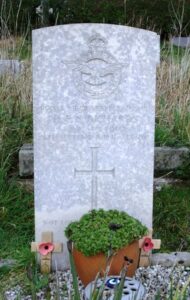
Archibald Elwyn Thomas, Trooper, 7957756, Royal Armoured Corps. Archie was the son of Thomas Benjamin Thomas and Jane Thomas (nee Hay), of Tenby. He served with the 48th Royal Tank Regiment, part of the Royal Armoured Corps. They were equipped with the Churchill Tank, and fought in North Africa and Italy during the war. Archibald must have been wounded at some time, and returned home for treatment. He died on 29 January 1945, aged 22, and is buried at Tenby (St. Mary) Church Cemetery.
